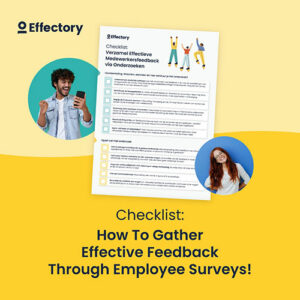Q: How Did You Build Effectory’s Feedback Culture?
1. Emphasize Autonomy and Forget Micromanagement
We’re big believers in trusting our people to do the best job they can with the resources we give them.
This means that while we always encourage employees to ask their managers or peers for advice and help, we would never impose our own opinions or ways of doing things on others. Especially when we see team members doing great things on their own.
Giving our employees autonomy is not just about letting them set their own priorities or trusting them to make decisions that maximize the company’s value. Autonomy is also the freedom to act on and share feedback at all levels of the organization.
Christian de Waard, CEO Effectory
One of the ways you can enable autonomy in your own organization is by giving people all the critical business information they need to know what’s going on and to form their own opinions – even if those opinions differ from yours.
2. Train Feedback Discipline and Feedback Hygiene
In our quest to make peer-to-peer and peer-to-manager feedback as fruitful as possible, we teach our people to specify exactly what kind of feedback they need and want.
Feedback discipline looks different for every company. One way you could approach it is by setting feedback boundaries (telling others what kind of feedback you don’t want) and explaining how the feedback will be used and why it was requested in the first place.
How to gather feedback from your employees
The definitive checklist for creating your employee engagement survey.
Download
3. Organize Simple and Regular Feedback Sessions
Schedule regular check-ins between team members and their managers to provide feedback on performance, find areas for improvement, and create a development plan.
Pulse surveys are short and sweet and are the perfect tool for gathering this type of feedback, as they’re sent monthly, quarterly, or even weekly. In fact, “Gallup has found that when managers provide weekly (vs. annual) feedback, team members are:
- 5.2x more likely to strongly agree that they receive meaningful feedback
- 3.2x more likely to strongly agree they are motivated to do outstanding work
- 2.7x more likely to be engaged at work”
Our recommendation would be to limit the length of the pulse survey to 7 questions. This’ll ensure that your employees won’t get tired and drop out.
When it comes to progress reviews, it’s also better to ask colleagues to rate each other instead of themselves. That’s because people tend to procrastinate when they need to honestly evaluate their own progress. (Lencioni, 2023)
4. Use Anonymous Surveys to Balance Out In-Person Feedback Sessions
Not all feedback should be anonymous, but it helps to provide your employees with at least one anonymous communication channel. It’s up to you whether you want to make it digital, like an online survey, or physical, like a complaint box in the back of the office.
Having this outlet will give your employees a safe place to express their opinions and feedback, especially if they don’t feel comfortable saying their thoughts out loud.
5. Lead by Example and Set the Stage for Collaborative Problem Solving
In many organizations, it’s considered taboo to share business challenges or problems with the team. Business blunders are often treated as “dirty” secrets for fear of demotivating or even scaring employees. But we believe the opposite is true!
As a leader, it’s important to level the playing field by being open and sharing your dilemmas with your team without shame. This allows your employees to approach problem solving as a team, and helps you resolve business challenges quickly and creatively.
Don Griffioen, Chief Strategy Officer
You should also proactively ask employees for feedback on your leadership performance. You can do this by setting up a team-level survey.
6. Provide Communication Training & Ongoing Support
Provide training for team members on how to give and receive feedback effectively, how to listen actively, and how to respond constructively. While some of these skills may come naturally to you, others may not be so confident.
Free handbook: Achieving excellence with your employees
Achieving excellence with your employees is a practical handbook of approximately 80 pages that provides insights into all HR variables that are important…
Download
Equipping employees with practical tools such as the DESC technique, which stands for describe, express, specify, and consequences, can help individuals express what they want their colleagues to do more, less, or differently to improve performance. This can encourage people to proactively provide feedback outside of specific initiatives such as annual surveys or company meetings.
And don’t forget that communication skills need refreshing!
The best approach is to include feedback training in the onboarding phase of the employee journey and then follow up occasionally when you feel those skills need refreshing.
Don Griffioen, Chief Strategy Officer
If you’re not sure what your employees’ training needs are, it’s always a good idea to conduct a short personal development survey.
7. Celebrate and Reward Feedback and Make It Clear to Everyone That Their Opinions Matter
We always do our best to highlight the benefits and the positive impact of our employees’ feedback, not only internally within the company, but also externally. For example in society or within other companies.
Don Griffioen, Chief Strategy Officer
One way you could approach this is to celebrate instances where feedback has been given and received positively and emphasize the benefits of open communication to the team. For example, you can publicly recognize individuals who have provided feedback that has led to positive change. This can be done through company-wide emails, announcements, or during team meetings.
If you’re using anonymous online surveys to gather feedback, consider adding incentives – such as Easter eggs, gift cards, or gamification elements – to encourage participation and make employees feel like they’re being rewarded for their time. One gamification element we use in our surveys that has been incredibly successful is the animated smiley face above the eNPS (Employee Net Promotor Score) score toggle.
8. Create Interactive Environments in Which People Can Have a Voice
An easy way to do this is to explicitly invite people to take part in meetings and reviews. If you see someone sitting quietly but think they might have valuable input, approach them directly and invite them to contribute to the discussion.
When team members are given the platform, they are more likely to speak up. This will also teach people to give spontaneous and on-the-spot feedback, slowly shifting behaviors toward a feedback-driven culture.
If people don’t feel comfortable speaking up, give them a way to quickly write or draw their opinion. For example, by leaving a smiley face or a sad face on the whiteboard in the meeting room.
Global Employee Engagement Index™
Discover the Global Employee Engagement Index™ 2025 for key insights on driving employee engagement, improving performance, and enhancing team dynamics.
Download
9. Set Up a System of Team Rewards
Instead of rewarding individuals, try rewarding teams when they meet or exceed goals. This encourages team accountability because people are unlikely to want to “let down” their colleagues with their own poor performance. (Lencioni, 2023) It also encourages team members to support and give feedback to underperforming colleagues and motivates them to take initiative and put in extra work when needed to achieve team goals. (Lencioni, 2023)
10. Learn To Deliver “Bad News”
While it may feel counterintuitive to share bad news, it’s necessary to get important information out there – no matter how terrible it may seem.
Especially in times of crisis, it’s important to be honest and transparent when things go wrong. Not only externally, but also internally – for example, within teams or organizations.
One of the best approaches is to deliver negative news in person. Whether it is a negative performance review or telling a colleague that you disagree with their behavior, an honest face-to-face conversation can really help avoid misunderstandings and resolve the situation faster.
An important prerequisite for employees, managers, and leaders to feel comfortable delivering bad news is psychological safety.
11. Promote Psychological Safety & Foster A Blame-Free Environment
At Effectory, it’s possible to conduct a psychological distress scan among your employees. Once you know how your employees are feeling and how psychologically safe their environment is, you’ll be able to take corrective action.
In her book, The Fearless Organization (2018), Edmondson details the components of a psychologically safe workplace and how to build one. Key steps include:
- Setting expectations
- Emphasizing purpose
- Demonstrating humility
- Developing deep and active listening skills
- Establishing structures and processes, and creating forums for input
- Recognizing strong work and thanking others
- De-stigmatizing failure
Taking these steps will help create an environment where mistakes are seen as opportunities for learning and growth, rather than reasons for punishment or blame.
12. Recognize and Act on Feedback
Ensure that feedback is taken seriously and acted upon promptly so that team members feel their input is valued and respected. At Effectory, we call these the “Empower” and “Optimize” stages of the feedback process, and they’re a critical part of every survey we set up for our clients.
The goal here is to use data-driven insights to find areas for improvement and implement best practices and suggestions at the individual, team, and organizational level.
13. Identify and Remove Feedback Blockers
Are you seeing a low survey response rate? There are multiple reasons why employees don’t or only partly participate in your feedback efforts.
Just one example of a blocker we’ve seen in our work is culture. Communication that works in Europe may not work when copied and pasted to Asia, South America, or the US. That’s because different cultures have different ways of giving feedback and working together.
The more subsidiaries or international offices you have, the greater the need for feedback. But the starting points for different people become much more diverse and complex.
Christian de Waard, CEO Effectory
As an HR professional, you need to develop strategies to address the different feedback cultures in your organization and tailor your messages accordingly. Showing up somewhere in person and talking to people on the shop floor can also be very helpful in understanding what’s preventing people from giving feedback or participating in a survey.
14. Start slow, grow steadily
Many companies want to go from 0 to 100 overnight, especially when they’re faced with a new feedback tool. But with feedback culture comes a sense of risk.
Christian de Waard, CEO Effectory
In risk-averse organizations, it’s wise to take it one step at a time to avoid culture clashes and survey fatigue. This is where a continuous listening approach can help – a consistent and safe way to share feedback anonymously.
15. “Build the cathedral together”
One of the first conversations Don remembers having when he joined Effectory 18 years ago was when the founders asked him for feedback.
“You have a fresh set of eyes, whereas we’ve stopped seeing the obvious. 70% of the time we may have a smart answer to why we do something, but the other 30% is where growth and innovation happens.”
What the founders called the innovation gap, Don calls the “upward spiral” — a connection between the company and the individual employee that climbs, layer by layer, toward business success. It allows people to use their talents to the fullest. And that, in turn, acts as a catalyst for business growth.
Build the cathedral together by allowing people to give feedback freely. This freedom is what helps their true talents unfold. As people give feedback, they discover new solutions and begin to innovate within their teams.
Don Griffioen, Chief Strategy Officer
Q: What have been the biggest challenges in building a strong feedback culture at Effectory?
Building a feedback culture is ongoing work. It needs constant attention and nurturing, and the efforts don’t end at conducting an employee survey.
Leaders and HR professionals need to continually clarify expectations – especially around the implementation of employee feedback and what happens with the results.
When can people expect changes? What kind of changes will they be? Why will some issues be addressed by management and others not?
When these questions come in, be prepared to be open and honest about the company’s capacities and priorities.
Q: What have been the biggest wins and positive impacts of having a feedback culture?
One of the biggest wins was the faster adoption of the company strategy by employees. If you ask people to think along with you, you’re going to embed the business strategy in them, almost automatically. And once it’s embedded, they become a part of building that strategy, along with their leaders and their peers.
Christian de Waard, CEO Effectory
A strong feedback culture also drives business performance, as we saw in Part 1 of this series. For example, it helps with retention because it allows employees to openly discuss their desire to leave the company. It also encourages innovation within teams.
Another thing we’ve seen is that people are developing at a faster rate. A feedback culture helps the company recognize and celebrate talent, and that has a ripple effect both inside and outside the organization. Also when it comes to attracting new talent.
Don Griffioen, Chief Strategy Officer
In that sense, a strong feedback culture creates a new value proposition for potential future colleagues.
Last but not least, a feedback culture helps drive purpose and strengthens the overall company strategy by allowing people to weigh in.
What we often see is management imposing the company purpose on their employees without ever asking for their input or trying to understand if this purpose resonates with the people. Driving purpose in your organization can only be successful if you listen to your people and allow them to contribute.
Christian de Waard, CEO Effectory
Q: What are you most proud of about Effectory’s feedback culture?
As banal as it may sound, I’m most proud of the fact that our people “dare” to challenge us. One situation I clearly remember is a conversation I had with a second-day intern in our Amsterdam office. We were talking about compensation and how it should be linked to the value a person brings to the company. I mentioned that, as CEO, I have the highest salary in the organization. Which means I need to show for adding value to the company. And then the intern looked me straight in the eye and said: “And what exactly is the value you bring to the table?” I was stunned. But at the same time, it made me realize that if he feels comfortable challenging me to my face on his second day, then we have really come a long way as an organization. And that the culture of direct feedback that we have at Effectory is really something to be proud of.
Christian de Waard, CEO Effectory
What I love about our feedback culture at Effectory is that as a leader, I don’t always have to know the answer. I just need to know which questions to ask. And then my people usually come up with a brilliant answer or solution that is better than what I would have thought of myself. Not only does this empower me, but also my employees.
Don Griffioen, Chief Strategy Officer
Conclusion
Building a feedback culture isn’t easy. And it usually takes a long time. But if you make the commitment, you’ll quickly see the wonderful effect a strong feedback culture can have on your own organization.
Of course, it’s always easier to get started with an experienced partner at your side. That’s where Effectory can come in and support your efforts.
If you’re interested in learning more about how we can help, sign up for a free demo below.
Book a free demo. See our solutions in action.
Effectory is Europe's Leading provider of Employee Listening Solutions. Schedule a product demo and discover how to enhance your employees' engagement.
Demo request
Sources
Lencioni, P. (2023). The Five Dysfunctions of a Team Hardcover – 9 Jan 2006 by Patrick Lencioni (Author).
Edmondson, A. C. (2018). The Fearless Organization: Creating Psychological Safety in the Workplace for Learning, Innovation, and Growth. Wiley.
Coyle, D. (2018). The Culture Code: The Secrets of Highly Successful Groups. Random House.




